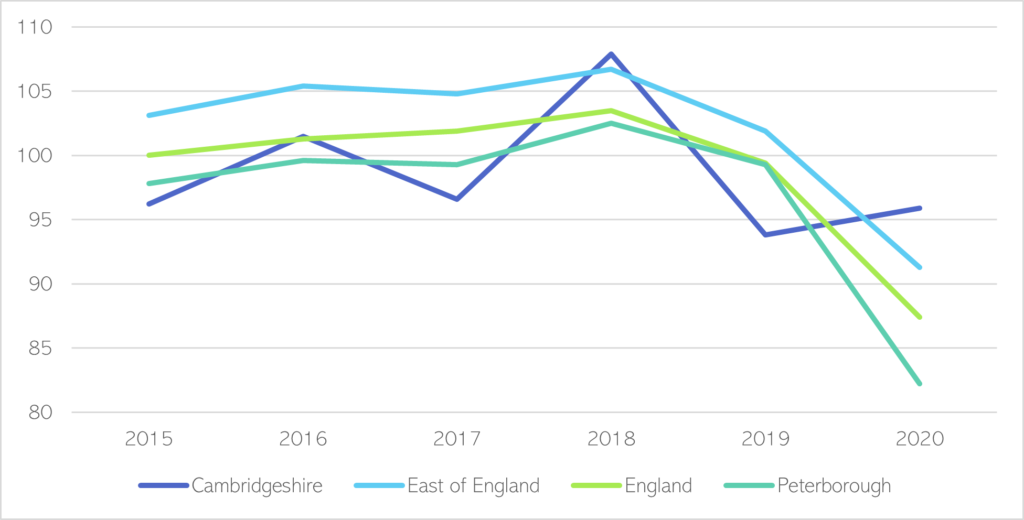Community Wellbeing
Good mental health and wellbeing is an important health outcome in its own right and can improve resilience to mental and physical illness.
Why is wellbeing important to mental health?
- Wellbeing is a subjective measure of how people feel about their lives. It can be defined using a range of measures, spanning people’s day-to-day satisfaction and happiness, to how they feel about their future.
- Wellbeing is related to, yet distinct from, mental health.
- Some people may have poor wellbeing without having a diagnosable mental health condition.
- Equally, people with long-term mental health conditions who manage their symptoms well can have a good quality of life and high wellbeing.
- Children and adults with better wellbeing are more able to deal with stressful events, recover faster from illnesses, and are less likely to put their health at risk (4). People with higher wellbeing are 1.14 times more likely to recover and survive from an illness than those with lower baseline wellbeing levels (115).
- Loneliness is an important risk factor for poor mental health (116). Older adults who feel isolated have a greater risk of later showing symptoms of anxiety and depression (117).
What is the national picture?
- National wellbeing has returned to pre-COVID levels across 4 different indicators (life satisfaction, feeling things done in life are worthwhile, happiness, and anxiety)(118).
- The vast majority (83%) of people feel like the areas they live is a place where people from different backgrounds get along well together, which is fairly consistent with data over the last 7 years (119).
- 65% of people agree that ‘people in their neighbourhood pull together to improve the neighbourhood’. This is a substantial rise from 2019/20 figures (59%) (119).
- Children in the UK are ranked among the most unhappy and least likely to have a positive sense of purpose of life in Europe. Poor wellbeing in children is strongly linked to fear of failure (120).
- There are inequalities in wellbeing (119):
- People living in more deprived neighbourhoods are significantly less likely to be satisfied by their local area.
- Similar disparities are present in the proportion of people who ‘feel a sense of belonging’ to their local community.

Figure 33: Percentage of people satisfied with their local area by IMD quintile. Source: Department for Digital, Culture, Media and Sports 2022
Loneliness
- 87% of adults (over 16s) in Great Britain agreed that they can rely on people in their life if they have a serious problem and 66% reported that they generally they trust most people (121).
- In England, 6.5% of adults reported feeling lonely often or always in 2020/21, a similar proportion of 2019/20 (6.4%) (121).
- There are a wide range of risk factors for loneliness:

Figure 34: Risk factors for loneliness.
What is the local picture?
- In Peterborough personal wellbeing has declined since 2015 and falls substantially below the national average (122). In contrast, personal wellbeing increased in Cambridgeshire from 2019 to 2020, going from the bottom 5% of local authority areas to being in the top 5% (122).
- Personal wellbeing is a combined score of feelings of anxiety, happiness, life satisfaction, and people’s belief that activities in life are worthwhile.

Figure 35: Personal wellbeing Health Index scores from 2015 to 2020. A score of 100 represents the English average in 2015. Data source: (122)
- Data collected from Cambridgeshire secondary schools in 2021 indicates pupils have lower resilience and poorer wellbeing on many measures compared to previous years, and that overall life satisfaction has fallen (123).
Loneliness
- 6 to 13% of the population aged over 65 are likely to be lonely most or all of the time (124). For Cambridgeshire, this would constitute between 7,100 and 15,400 adults aged over 65.
- Only half (47% in Cambridgeshire and 48% in Peterborough) of adult social care users in in C & P report having as much social contact as they would like (44).
Additional resources
- The local data pack gives an overview of key data and trends
- A review of the link between social ties and mental health
- Safeguarding the Convoy: A call to action from the Campaign to End Loneliness
- Further local data on wellbeing
References
Full list of references can be found here
115. Lamers SMA, Bolier L, Westerhof GJ, Smit F, Bohlmeijer ET. The impact of emotional well-being on long-term recovery and survival in physical illness: A meta-analysis. Vol. 35, Journal of Behavioral Medicine. 2012.
- Cacioppo JT, Hughes ME, Waite LJ, Hawkley LC, Thisted RA. Loneliness as a specific risk factor for depressive symptoms: Cross-sectional and longitudinal analyses. Psychol Aging. 2006;21(1).
- Santini ZI, Jose PE, York Cornwell E, Koyanagi A, Nielsen L, Hinrichsen C, et al. Social disconnectedness, perceived isolation, and symptoms of depression and anxiety among older Americans (NSHAP): a longitudinal mediation analysis. Lancet Public Health. 2020;5(1).
- Office for National Statistics. Personal well-being in the UK, quarterly: April 2011 to September 2021 [Internet]. Data and analysis from Census 2021. 2022 [cited 2022 Oct 3]. Available from: https://www.ons.gov.uk/peoplepopulationandcommunity/wellbeing/bulletins/personalwellbeingintheukquarterly/april2011toseptember2021
- DCMS. Community Life Survey 2020/21 [Internet]. Department for Digital, Culture, Media & Sport. 2022 [cited 2022 Oct 4]. Available from: https://www.gov.uk/government/statistics/community-life-survey-202021
- Thapar A, Stewart-Brown S, Harold GT. What has happened to children’s wellbeing in the UK? Vol. 8, The Lancet Psychiatry. 2021.
- Office for National Statistics. Measures of National Well-being Dashboard [Internet]. 2022 [cited 2022 Oct 25]. Available from: https://www.ons.gov.uk/peoplepopulationandcommunity/wellbeing/articles/measuresofnationalwellbeingdashboard/2018-04-25
- Office for National Statistics. How health has changed in your local area: 2015 to 2020 [Internet]. 2022 [cited 2022 Nov 10]. Available from: https://www.ons.gov.uk/peoplepopulationandcommunity/healthandsocialcare/healthandwellbeing/articles/howhealthhaschangedinyourlocalarea2015to2020/2022-11-09
- CCC/PCC Public Health Intelligence. COVID-19: Review of emerging evidence of needs and impacts on Children and Young People in Cambridgeshire and Peterborough [Internet]. 2022 [cited 2022 Oct 25]. Available from: https://cambridgeshireinsight.org.uk/coronavirus/impacts/
- Campaign to End Loneliness. Safeguarding the Convoy: A call to action from the Campaign to End Loneliness [Internet]. 2011 [cited 2022 Oct 25]. Available from: https://www.campaigntoendloneliness.org/wp-content/uploads/Safeguarding-the-Convoy.-A-call-to-action-from-the-Campaign-to-End-Loneliness.pdf
